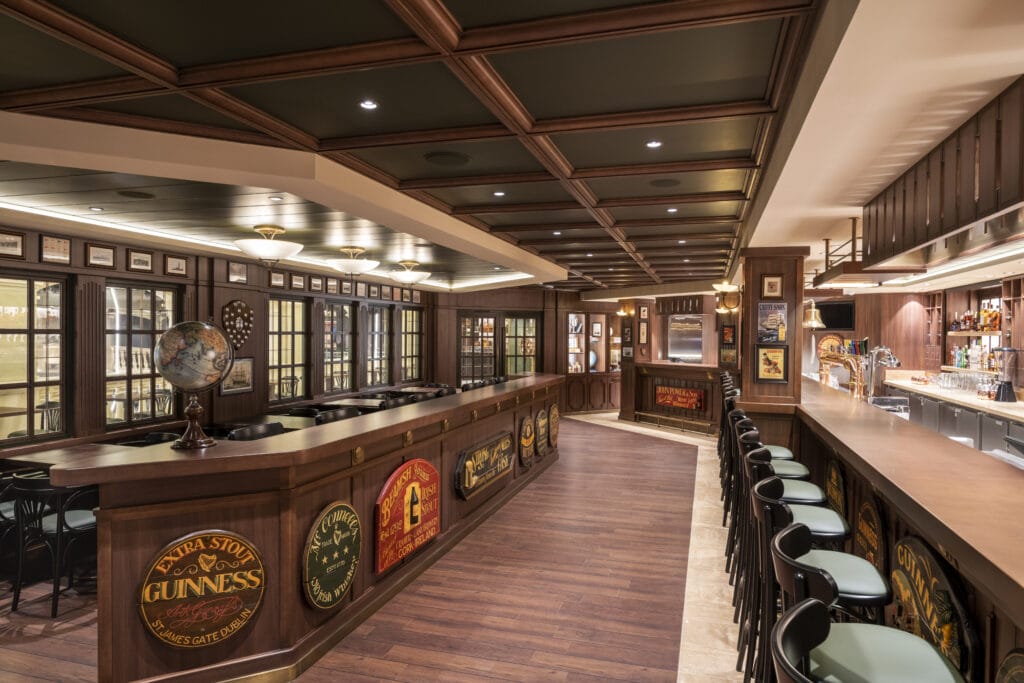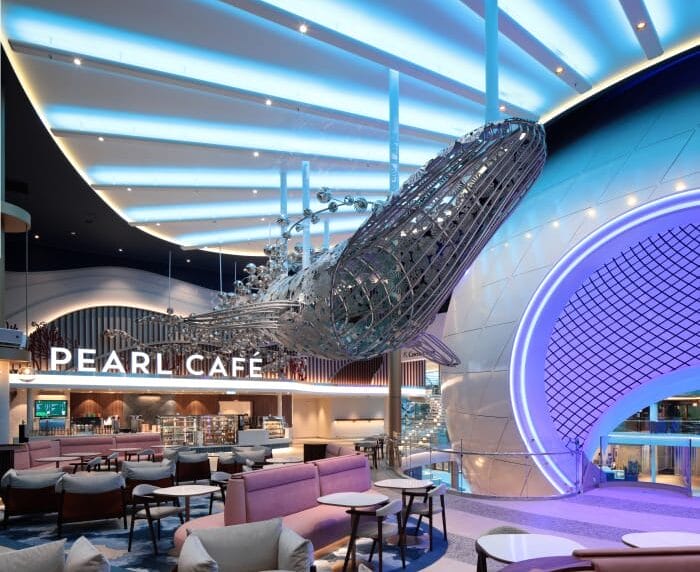When it comes to design, is art the finishing touch? Or does its integration into cruise ship interior design and guest experience run deeper than most are aware. From aiding storytelling to contributing to guest wellbeing, art is a powerful tool in the hands of the designer.
Telling a story
In CSI Award-nominated space Masters of the Sea, designed by SMC Design for MSC Virtuosa, art selection was essential to the storytelling of the space. The brief was a classic British pub. The design hallmarks of a British pub include etched glass, wood furnishings and colourways featuring deep reds and greens. However, the feel of the space is as important as the look of it. The best British pubs feel lived-in, welcoming, warm and homely. SMC Design delivered a space that felt authentic to the pubs on land while fulfilling cruise ship interiors design requirements.
In a live interview with Mike Abbot on the CSI+ platform, formerly Design Associate at SMC Design, now Senior Manager, Architect Concept Development at MSC Cruises, he explained the necessity of understanding the role of art in design practice. He said, ‘With architect companies like SMC Design, Tillberg Design of Sweden, they get involved in the interior design but they also need to have a grasp on signage and artwork. The three disciplines need to harmonise to become a solid product.’
The usual desired effect of art design is to give guests the impression of careful curation by an expert hand. SMC Design created the impression that unseen owners had added art to the walls piecemeal throughout the lifetime of the Masters of the Sea pub. To achieve this, SMC Design took a unique approach to the art design of the project. Although their vision for the space was strong from the start, Mike said that they didn’t need to pinpoint exact placement on the wall. The design intent was to create artwork that feels ‘collected, not selected’.


Creating impact
Art can be used in a way that transcends its traditional decorative function. Colm Mac Rory, Director, Spires Art, discussed with us the ways art can be combined with tech to expand guest experience. He said, ‘Beyond static pictures, art can actively shape narratives, transporting guests into worlds woven through installations, murals, and interactive displays. Imagine a museum using projections to animate historical scenes on sculptures, or a hotel lobby featuring a kinetic art piece that responds to movement, creating a dynamic narrative around arrival.’
Cruise brands have already started to tap into the potential of tech-enhanced installations. Royal Caribbean’s record-breaking new ship Icon of the Seas will feature large kinetic sculpture The Pearl.
The Pearl spans the height of three decks, its main materials include steel and glass. The internal tiles, arranged in a Fibonacci sequence, move in pulsing patterns according to real-time tidal and wind data from the Caribbean. The towering and ever-changing structure is one of the first things guests encounter when boarding the ship. Not only does the artwork provide an immersive experience for guests, it sets the tone of the ship experience. The Icon of the Seas is the world’s largest ever cruise ship, promising ‘thrills you never dared to imagine’. You can imagine that guests encountering The Pearl on arrival would instantly feel transported to a new realm of adventure.

Enriching guest experience
Art can enrich our experience of the world around us. This ranges from our understanding of other cultures to our own health and wellbeing. Colm Mac Rory, Director, Spires Art, said, ‘Art bridges cultures and celebrates diversity. Incorporating artworks from various backgrounds or using art forms specific to a region can enrich a space, allowing guests to connect with different traditions and perspectives.’
Coral Expeditions’ Coral Geographer is adorned throughout with indigenous artworks that ‘share stories from the remote cultures and destinations we visit worldwide and our Australian homeland’. They boast an extensive collection of Australian indigenous art. The art is installed throughout the cruise ship’s interior spaces. The subjects explore the flora and fauna of Australia. On Holland America’s 2023 Alaskan cruises, the cruise brand incorporated intricate art on their menus. Tlingit and Athabascan social designer and artist Rico Lanáat’ Worl created the complex artwork.
Enabling guest wellbeing
Rebecca Cresswell, Director, Cresswell Creations, identified that one of the purposes of art curation can be to impact guest wellness. Art provides guests a point of interaction with the space. Commonly, art engages the sense of sight, but Rebecca points out that this is only one of the ways art can engage guests. She points to tactile sculptures and artworks that engage the sense of touch as ways to engage sight-impaired guests. Designers are increasingly thinking of ways to incorporate accessibility into their designs. Art can help take accessibility providing equal access to the function of a space and opening it up to equal access to the experience of a space.
It is well-known that art has the ability to impact guests’ mood. Rebecca suggests harnessing this power to create spaces to benefit passengers with different neurological needs. She said, ‘Quiet spaces with calming yet engaging works can aid those viewers who may be on the autistic spectrum and would welcome a calmer source of stimulation such as light art or modernist paintings with calming colours or the soothing forms of a tactile sculpture.’
Cruise brands such as Celebrity Cruises already offer specialist cruises such as autism-friendly cruises. Art offers designers a fresh way to embed accessible experiences into the design of cruise ship interiors. By carefully deploying art, designers can enhance spaces that to be both visually pleasing and have hidden functions.
In fact, according to a report published by the UK Government in 2017, access to art can benefit everyone. The expansive report looked at several arts and health programs running across the UK and observed many benefits. One arts program identified that of its participants, 79% ate more healthily, 77% engaged in more physical activity and 82% enjoyed a greater sense of wellbeing after engaging with the arts. This shows that every guest on board a cruise ship can benefit from an extensive and well-considered art program.
Art and beyond
Ultimately, the role of art extends far beyond its decorative function. It is a multifaceted tool that can be wielded by the designer to enrich guest experience, deepen the storytelling of the space, foster cultural understanding and enhance guest wellness – and much more.
Want to stay up to date on the latest cruise interior industry developments and trends? CSI+ is the exclusive platform for Members-only networking and product sourcing for the global cruise interiors community. Not a Member yet? Get in touch with the team to learn more.
